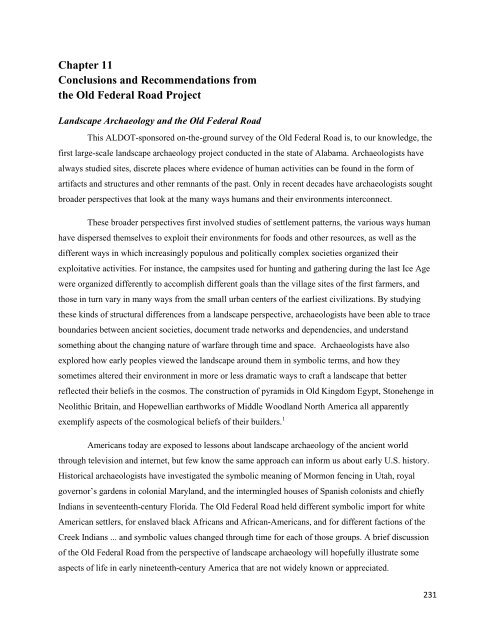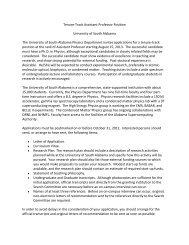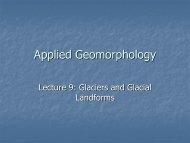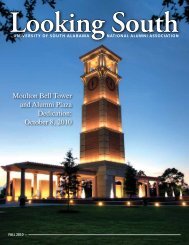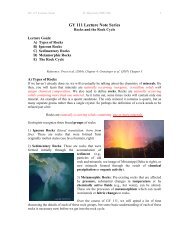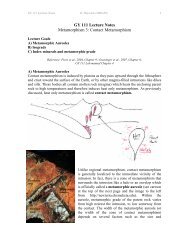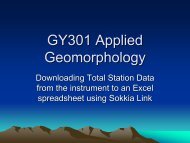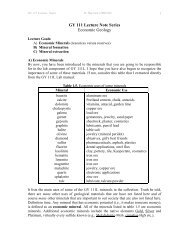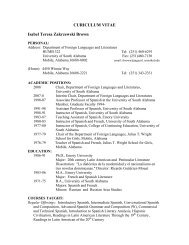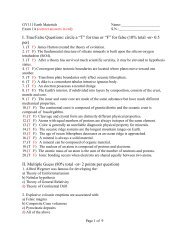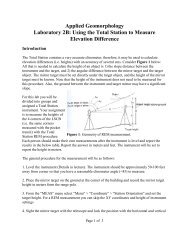Archaeological Survey of the Old Federal Road in Alabama
Archaeological Survey of the Old Federal Road in Alabama
Archaeological Survey of the Old Federal Road in Alabama
You also want an ePaper? Increase the reach of your titles
YUMPU automatically turns print PDFs into web optimized ePapers that Google loves.
Chapter 11Conclusions and Recommendations from<strong>the</strong> <strong>Old</strong> <strong>Federal</strong> <strong>Road</strong> ProjectLandscape Archaeology and <strong>the</strong> <strong>Old</strong> <strong>Federal</strong> <strong>Road</strong>This ALDOT-sponsored on-<strong>the</strong>-ground survey <strong>of</strong> <strong>the</strong> <strong>Old</strong> <strong>Federal</strong> <strong>Road</strong> is, to our knowledge, <strong>the</strong>first large-scale landscape archaeology project conducted <strong>in</strong> <strong>the</strong> state <strong>of</strong> <strong>Alabama</strong>. Archaeologists havealways studied sites, discrete places where evidence <strong>of</strong> human activities can be found <strong>in</strong> <strong>the</strong> form <strong>of</strong>artifacts and structures and o<strong>the</strong>r remnants <strong>of</strong> <strong>the</strong> past. Only <strong>in</strong> recent decades have archaeologists soughtbroader perspectives that look at <strong>the</strong> many ways humans and <strong>the</strong>ir environments <strong>in</strong>terconnect.These broader perspectives first <strong>in</strong>volved studies <strong>of</strong> settlement patterns, <strong>the</strong> various ways humanhave dispersed <strong>the</strong>mselves to exploit <strong>the</strong>ir environments for foods and o<strong>the</strong>r resources, as well as <strong>the</strong>different ways <strong>in</strong> which <strong>in</strong>creas<strong>in</strong>gly populous and politically complex societies organized <strong>the</strong>irexploitative activities. For <strong>in</strong>stance, <strong>the</strong> campsites used for hunt<strong>in</strong>g and ga<strong>the</strong>r<strong>in</strong>g dur<strong>in</strong>g <strong>the</strong> last Ice Agewere organized differently to accomplish different goals than <strong>the</strong> village sites <strong>of</strong> <strong>the</strong> first farmers, andthose <strong>in</strong> turn vary <strong>in</strong> many ways from <strong>the</strong> small urban centers <strong>of</strong> <strong>the</strong> earliest civilizations. By study<strong>in</strong>g<strong>the</strong>se k<strong>in</strong>ds <strong>of</strong> structural differences from a landscape perspective, archaeologists have been able to traceboundaries between ancient societies, document trade networks and dependencies, and understandsometh<strong>in</strong>g about <strong>the</strong> chang<strong>in</strong>g nature <strong>of</strong> warfare through time and space. Archaeologists have alsoexplored how early peoples viewed <strong>the</strong> landscape around <strong>the</strong>m <strong>in</strong> symbolic terms, and how <strong>the</strong>ysometimes altered <strong>the</strong>ir environment <strong>in</strong> more or less dramatic ways to craft a landscape that betterreflected <strong>the</strong>ir beliefs <strong>in</strong> <strong>the</strong> cosmos. The construction <strong>of</strong> pyramids <strong>in</strong> <strong>Old</strong> K<strong>in</strong>gdom Egypt, Stonehenge <strong>in</strong>Neolithic Brita<strong>in</strong>, and Hopewellian earthworks <strong>of</strong> Middle Woodland North America all apparentlyexemplify aspects <strong>of</strong> <strong>the</strong> cosmological beliefs <strong>of</strong> <strong>the</strong>ir builders. 1Americans today are exposed to lessons about landscape archaeology <strong>of</strong> <strong>the</strong> ancient worldthrough television and <strong>in</strong>ternet, but few know <strong>the</strong> same approach can <strong>in</strong>form us about early U.S. history.Historical archaeologists have <strong>in</strong>vestigated <strong>the</strong> symbolic mean<strong>in</strong>g <strong>of</strong> Mormon fenc<strong>in</strong>g <strong>in</strong> Utah, royalgovernor’s gardens <strong>in</strong> colonial Maryland, and <strong>the</strong> <strong>in</strong>term<strong>in</strong>gled houses <strong>of</strong> Spanish colonists and chieflyIndians <strong>in</strong> seventeenth-century Florida. The <strong>Old</strong> <strong>Federal</strong> <strong>Road</strong> held different symbolic import for whiteAmerican settlers, for enslaved black Africans and African-Americans, and for different factions <strong>of</strong> <strong>the</strong>Creek Indians ... and symbolic values changed through time for each <strong>of</strong> those groups. A brief discussion<strong>of</strong> <strong>the</strong> <strong>Old</strong> <strong>Federal</strong> <strong>Road</strong> from <strong>the</strong> perspective <strong>of</strong> landscape archaeology will hopefully illustrate someaspects <strong>of</strong> life <strong>in</strong> early n<strong>in</strong>eteenth-century America that are not widely known or appreciated.231


